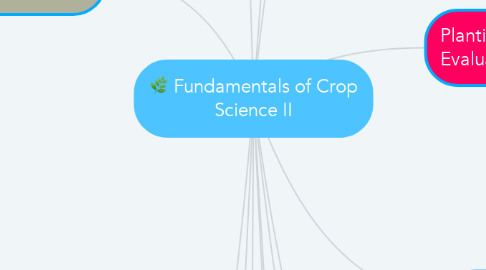
1. Cropping Systems
1.1. Types of cropping system
1.1.1. Monocropping
1.1.2. Multiple Cropping
1.1.2.1. Intercropping
1.1.3. Mixed Cropping
1.1.4. Sequential
1.1.5. Crop Rotation
2. Pest Management
2.1. Pests
2.1.1. Pathogen
2.1.2. Insects and Mites
2.1.3. Weeds
2.1.4. Vertebrate Pests
2.2. Integrated Pest Management
2.2.1. Varietal Resistance
2.2.2. Biological Control
2.2.3. Physico-Cultural Control
2.2.4. Pesticides
2.3. Integrate Weed Management
2.3.1. Physical/Mechanical
2.3.2. Cultural
2.3.3. Chemical
3. Primary and Secondary Processing
3.1. Primary Processing
3.1.1. Extraction of Primary Economic Product
3.1.1.1. Threshing
3.1.1.2. Shelling
3.1.1.3. Decortification
3.1.1.4. Retting
3.1.1.5. Tuxying
3.1.2. Drying
3.1.3. Fermentation
3.2. Secondary Processing
3.2.1. Heat Sterilization
3.2.2. Dehydration
3.2.3. Fermentation
3.2.4. Freezing
4. Harvesting and Post-production Technologies
4.1. Methods of harvesting
4.1.1. Priming
4.1.2. Stripping
4.1.3. Tapping
4.1.4. Manual
4.1.5. Manual with the aid of conveyor
4.1.6. Mechanical
4.2. Methods of determining maturity
4.2.1. Visual
4.2.2. Physical
4.2.3. Compositional
4.2.4. Phenological
4.3. Type of Crops
4.3.1. Perishable
4.3.1.1. Trimming
4.3.1.2. Cleaning
4.3.1.3. Sorting and Grading
4.3.1.4. Ripening
4.3.1.5. Edible Coating
4.3.1.6. Storage
4.3.2. Durable
5. Soil and Nutrient Management
5.1. Fertilization
5.1.1. Requirements
5.1.2. Materials
5.1.3. Placement
5.1.4. Application
5.2. Crop Nutrient Removal
5.2.1. Erosion
5.2.2. Volatilization
5.2.3. Leaching
6. Planting Site Selection and Evaluation
6.1. Approach in Assessment
6.1.1. Quantitative
6.1.2. Qualitative
6.2. Evaluation of Environment
6.2.1. Suitable Site
6.2.1.1. Environmental
6.2.1.2. Climactic
6.2.1.3. Bio-physical
7. Planting Methods
7.1. Direct Seeding
7.2. Transplanting
7.3. Population Density
8. Land Preparation
8.1. Upland
8.2. Lowland
8.2.1. Harrowing
8.2.2. Plowing
8.2.3. Furrowing
8.3. Hilly
9. Selection and Preparation of Planting Materials
9.1. Recommended varieties
9.2. Mode of Propagation
9.2.1. Sexual
9.2.2. Asexual
10. Water Management
10.1. Irrigation
10.1.1. Surface
10.1.1.1. Flooding Method
10.1.1.2. Furrow Method
10.1.1.3. Basin Method
10.1.2. Sprinkler
10.1.3. Drip System
10.1.4. Sub-surface
10.2. Issues
10.2.1. Lack of Water
10.2.2. Excess Water
11. Ornamental Horticulture
11.1. Floriculture
11.2. Landscape Horticulture
11.3. Turfgrass Management
12. Control of Growth and Development
12.1. Uses of Plant Growth Regulators
12.2. Physical Methods
12.2.1. Training
12.2.1.1. Trellising
12.2.2. Pruning
12.2.2.1. Preventive
12.2.2.2. Formative
12.2.2.3. Rejuventaive
12.2.2.4. Corrective
12.3. Windbreak Establishment
13. Issues in Crop Production
13.1. Local
13.1.1. High Importation of Cereals
13.1.2. Lack of government support
13.2. Global
13.2.1. Diminishing Land Area
13.2.2. Covid-19 Pandemic
